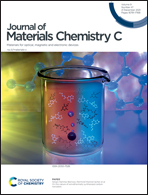On the crystal structure thermal evolution of formamidinium lead tribromide, CH(NH2)2PbBr3†
Abstract
Although methylammonium lead triiodide (CH3NH3PbI3) is recognized as the best candidate for photovoltaic applications, unfortunately it undergoes fast degradation when exposed to moisture and mild temperatures. Among hybrid organic–inorganic perovskites, formamidinium lead tribromide (FA: formamidinium, CH(NH2)2+) is an excellent alternative given its long-term stability. Here we present a structural study from synchrotron X-ray and neutron diffraction of an undeuterated FAPbBr3 specimen, carried out to follow its crystallographic behaviour in the 1–298 K temperature range. Two phase transitions are identified; at 256–261 K from the cubic structure observed at RT (Pm![[3 with combining macron]](https://www.rsc.org/images/entities/char_0033_0304.gif) m), to a tetragonal symmetry (P4/mbm), and at 159–160 K to an orthorhombic phase (space group Pnma). Our neutron diffraction data allowed us to unveil the configuration of the organic FA units and their full localization within the mentioned temperature range, thus improving the crystallographic description of this compound. The evolution with temperature of the H-bonds between the organic molecule and the inorganic cage is followed. The UV-Vis diffuse reflectance spectrum shows a band gap of 2.23 eV, making it a suitable material for optoelectronic devices.
m), to a tetragonal symmetry (P4/mbm), and at 159–160 K to an orthorhombic phase (space group Pnma). Our neutron diffraction data allowed us to unveil the configuration of the organic FA units and their full localization within the mentioned temperature range, thus improving the crystallographic description of this compound. The evolution with temperature of the H-bonds between the organic molecule and the inorganic cage is followed. The UV-Vis diffuse reflectance spectrum shows a band gap of 2.23 eV, making it a suitable material for optoelectronic devices.



 Please wait while we load your content...
Please wait while we load your content...